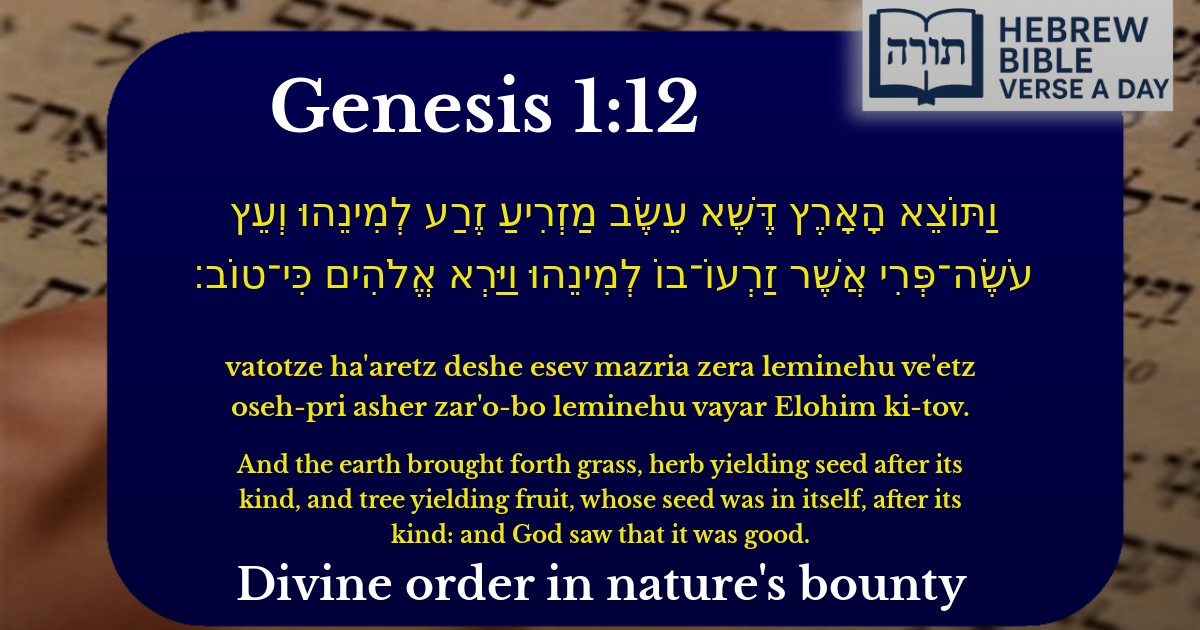Join Our Newsletter To Be Informed When New Videos Are Posted
Join the thousands of fellow Studends who rely on our videos to learn how to read the bible in Hebrew for free!
Hebrew Text
וַתּוֹצֵא הָאָרֶץ דֶּשֶׁא עֵשֶׂב מַזְרִיעַ זֶרַע לְמִינֵהוּ וְעֵץ עֹשֶׂה־פְּרִי אֲשֶׁר זַרְעוֹ־בוֹ לְמִינֵהוּ וַיַּרְא אֱלֹהִים כִּי־טוֹב׃
English Translation
And the earth brought forth grass, herb yielding seed after its kind, and tree yielding fruit, whose seed was in itself, after its kind: and God saw that it was good.
Transliteration
Vatotze ha'aretz deshe esev mazria zera leminehu ve'etz oseh-pri asher zar'o-bo leminehu vayar Elohim ki-tov.
Hebrew Leining Text
וַתּוֹצֵ֨א הָאָ֜רֶץ דֶּ֠שֶׁא עֵ֣שֶׂב מַזְרִ֤יעַ זֶ֙רַע֙ לְמִינֵ֔הוּ וְעֵ֧ץ עֹֽשֶׂה־פְּרִ֛י אֲשֶׁ֥ר זַרְעוֹ־ב֖וֹ לְמִינֵ֑הוּ וַיַּ֥רְא אֱלֹהִ֖ים כִּי־טֽוֹב׃


The Earth's Productive Power
The verse describes the earth's divinely ordained ability to produce vegetation. Rashi (Bereshit 1:12) emphasizes that this was not a gradual process, but rather an immediate fulfillment of Hashem's command - the earth brought forth fully grown plants, grasses, and trees in their complete state, ready to produce seeds according to their kinds.
The Significance of "L'minéhu" (According to Its Kind)
The repetition of "l'minéhu" (according to its kind) teaches us about the fixed nature of creation. The Rambam (Moreh Nevuchim 2:6) explains this as demonstrating the unchanging laws of nature established by Hashem. The Midrash (Bereshit Rabbah 5:9) notes that even when species appear similar, each maintains its distinct characteristics as ordained during creation.
The Distinction Between Grasses and Trees
"Vayar Elokim Ki Tov" (And God Saw That It Was Good)
The Kli Yakar (Bereshit 1:12) explains that this declaration refers to the perfect balance in nature where each species reproduces according to its kind without intermixing. The Talmud (Chullin 60a) derives from this that Hashem created the vegetation with the capacity for continuous reproduction, ensuring the world's ongoing sustenance.
The Miracle Within Nature
The Seforno highlights that the phrase "whose seed was in itself" teaches that Hashem embedded the miraculous power of reproduction within the natural order. This demonstrates that what we perceive as "nature" is actually constant divine providence maintaining creation (Meshech Chochmah on Bereshit 1:11).